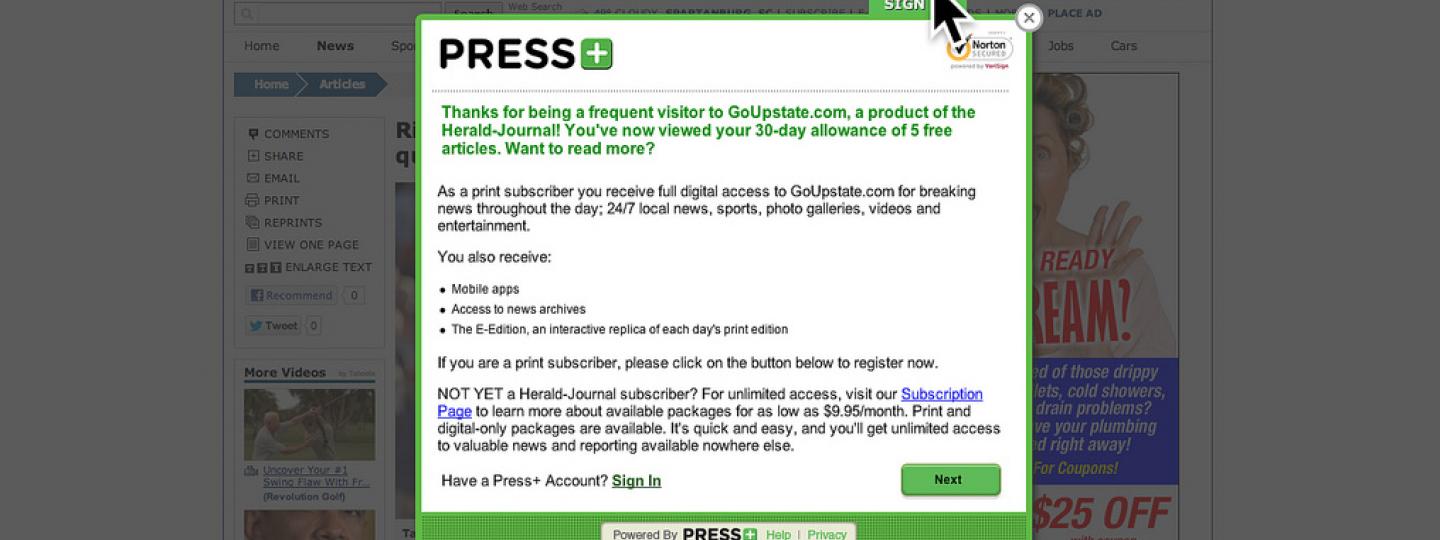In past columns, I’ve brainstormed how we might think differently about newsletters, headlines, homepages, bylines, analytics, podcast ideas, comment sections and covering the president.
It’s time to tackle paywalls.
Paywalls have now been around on news websites for over 20 years. (The Wall Street Journal, which led the way, went behind a strict paywall in 1996.) In the ensuing decades, many news sites have launched metered paywall — meaning non-paying customers can read a certain number of articles before encountering the paywall.
Paywalls sometimes come down for various reasons — the most common drops are for public emergencies or planned events — and there are workarounds for accessing most metered paywalls, as Ariel Stulberg detailed in CJR last May. Some publications allow readers to access more articles if they register first, and others require registration to see any articles. Some sites don’t count page views that come in from social media, and others — like the Journal — allow people to see articles that subscribers and staff members have shared. Some publications require people to answer survey questions before seeing content.
But for the most part, paywalls come up after people have clicked on a certain number of articles, which range by publication.
How could we think more broadly about triggering a paywall or taking it down? What other mechanisms could we use besides article count? Let’s brainstorm.
Time
Instead of tracking the number of total articles people read per month, what if we notified readers when they read a certain number of articles within a certain topic category, or when they reached a certain amount of engaged time on a particular article, beat, or reporter’s pieces?
This would allow readers to explore different topic areas, or check in on breaking news — and then ask them to pay when they clearly want to explore an issue more in-depth.
Another idea: triggering the paywall for readers who visit over a certain number of times in a certain time period, or dropping the paywall for readers who visit for the first time in a long time, or who are reading an article in a section they haven’t read before. Or perhaps paywalls operate like electric grids: they go up at peak times (or day) and come down at others — I realize this sounds silly, but what happens when we test it?
Aggregate behavior of readers
Imagine a paywall kicking in after an article reaches a certain number of views, or after a certain number of readers take a particular action, such as sharing the piece or writing a comment. Conversely, we could imagine a paywall existing and coming down after a certain number of readers take an action, such as sharing a piece or writing a comment.
Location and potential boredom of readers
Could readers outside of a certain geographic area be asked to pay for content? Could readers whose devices indicate they’re moving or traveling be asked to pay, when people sitting in an office aren’t? What are the ways that where someone is, and what other actions they might be taking, influence the way paywalls are triggered?
Behavior
We talk a lot about audience engagement and creating more two-way relationships with our readers. How might we think about behavior or engagement that would extend or reduce a paywall altogether? Adding a comment, sending a story idea, sharing a piece — how valuable are these? Or how could we think about behaviors that readers might take off-site that trigger or take down the paywall? Should someone purchasing something from Wirecutter receive a day or two of the New York Times? Is the first action more likely to lead to a subscription? Let’s test it.
Bundles with other activities
Could a donation to a public radio station trigger a paywall coming down on a local news site? What are ways news organizations could work together to increase both media and civic literacy and value for their readers? If you indicate that you’re a valued member of a community — and make thoughtful comments that elevate the discussion — on one news site, could that extend to elsewhere? (And what privacy implications would need to be considered?)
I list all of these ideas knowing that some are not workable, and some are somewhat preposterous — but I hope that they spark conversations and ideations that help us think more broadly about when to ask, what to ask for, and how to show readers that supporting news organizations is important.
We’ve had 20 years to contemplate the paywall, and not a whole lot has changed in that time — how might testing out new avenues lead to continued sustainability for our news?






